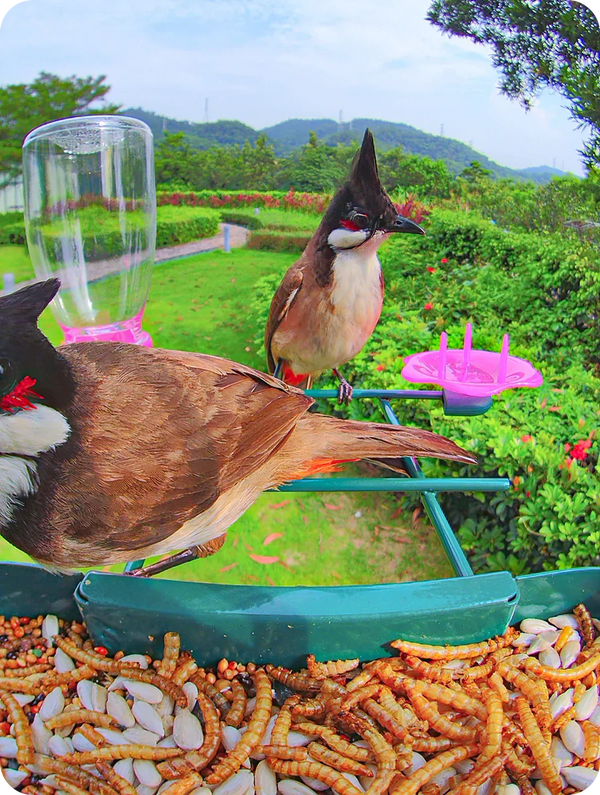Unlock the Secret to Attracting Birds: Discover the Perfect Suet-Compatible Feeder!
Attracting birds to your garden can transform your outdoor space into a lively sanctuary filled with beautiful sights and sounds. One of the best ways to entice a diverse range of feathered friends is by incorporating suet into your feeding routine. Suet, a high-energy food source made from animal fat, provides essential nutrients that help birds thrive, especially during colder months when natural food can be scarce. A bird feeder with suet compatibility is a fantastic investment for any bird enthusiast. Not only does it cater to various species, but it also ensures that your backyard becomes a vibrant hub for birdwatching. In this article, we'll explore the benefits of using suet, the types of feeders available, how to choose the right one for your space, and tips for maintaining your feeder to maximize your birdwatching experience.

Understanding Suet and Its Benefits for Birds
Suet is a nutrient-rich food made primarily from the fat of cattle, sheep, or other animals. It is especially beneficial for birds during the winter months when their natural food sources, such as insects and seeds, are less available. Birds like woodpeckers, nuthatches, and chickadees are particularly fond of suet, finding it an excellent source of energy to sustain them through harsh weather conditions. Suet is packed with essential fatty acids and protein, which are crucial for maintaining body heat and energy levels. Additionally, many suet cakes are blended with seeds, fruits, or insects, further enhancing their appeal to a variety of bird species. By providing suet, you're not only helping birds survive winter but also encouraging them to visit your yard regularly, creating a lively birdwatching environment.
Types of Bird Feeders Compatible with Suet
When it comes to bird feeders that accommodate suet, there are several options available. Tray feeders are a versatile choice, providing a flat surface where you can place suet cakes or loose suet. They attract multiple bird species but may require more frequent refilling due to their open design. Suet cages, on the other hand, are specifically designed to hold suet blocks securely. These feeders allow birds to cling while they feast, making them a popular choice among woodpeckers and other clinging birds. Combination feeders offer a great solution for those who want to provide both seeds and suet, catering to a wider range of birds. Each type of feeder has its advantages and disadvantages; tray feeders may attract squirrels, while suet cages can be more challenging to clean. Understanding these differences will help you select the best option for your backyard.
Choosing the Right Feeder for Your Backyard
Choosing the right suet-compatible feeder involves considering several factors. First, think about the location where you'll place the feeder. Ideally, it should be in a quiet area where birds feel safe, and also close enough to your home for you to enjoy watching them without disturbing them. Additionally, consider the bird species you wish to attract. For instance, if you're aiming for woodpeckers, a suet cage would be ideal, while a tray feeder might work better for attracting a broader variety of birds. Aesthetics also play a role; select a feeder that complements your garden's style. Finally, ensure that the feeder is easy to access for refilling and cleaning, as this will encourage consistent use and enjoyment.
Maintaining Your Bird Feeder
Proper maintenance of your bird feeder with suet is crucial for ensuring a safe and enjoyable feeding experience for your avian visitors. Regular cleaning is essential to prevent mold and bacteria growth, which can be harmful to birds. It's advisable to clean your feeder with hot, soapy water every couple of weeks, especially during warmer months when food can spoil quickly. Refilling the feeder should be done consistently to keep birds returning to your yard. It's also important to monitor for pests such as ants or squirrels, which can invade your feeder. By keeping your feeder clean and well-stocked, you'll create a welcoming environment that encourages birds to visit frequently, enhancing your birdwatching enjoyment.
Enhancing Your Backyard Bird Habitat
To create a truly inviting space for birds, consider additional elements that complement suet feeding. Providing a water source, such as a birdbath, is crucial, as birds need water for drinking and bathing. Native plants can also enhance your yard by offering natural food sources, shelter, and nesting sites. Planting a variety of flowers and shrubs will attract insects, which are another food source for many birds. Moreover, creating areas for shelter, like brush piles or dense shrubs, will help birds feel safe. By taking a holistic approach to your backyard, you can develop an environment that not only attracts birds with suet but also supports their overall well-being.
Creating an Inviting Habitat for Birds
In conclusion, a bird feeder with suet compatibility is an excellent addition to any backyard, providing essential nourishment to birds and enhancing your outdoor experience. By understanding the benefits of suet, exploring the various feeder options, and maintaining your setup properly, you can create an inviting space that attracts a diverse range of birds. Remember to consider additional elements that contribute to a bird-friendly habitat, as this will further enrich your birdwatching experience. So take action, set up your suet feeder, and enjoy the beauty and joy of birds in your backyard!







Comments